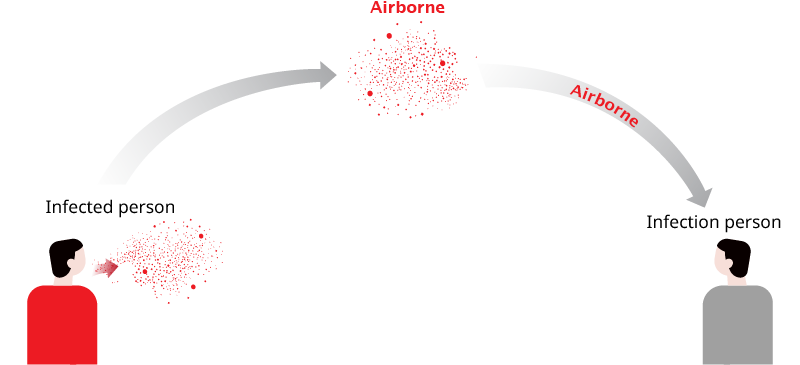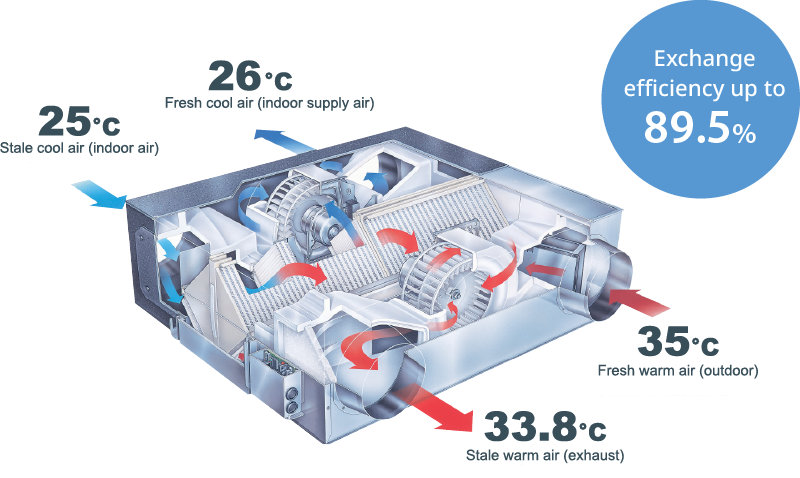

It is an undeniable fact that most people’s daily lives are spent in buildings or closed areas that do not have efficient air circulation. This is especially true for office buildings, educational institutions, hospitals, and various other establishments. Places without efficient ventilation management usually become areas where various contaminants, such as carbon dioxide, viruses, bacteria, PM 2.5 fine dust particles, and formaldehyde, as well as airborne viruses, can exist for an extended period of time and can potentially spread as far as 2–3 meters, causing people who live and work in closed areas to be exposed to such contaminants even though there is distancing or even no direct contact.
One way to mitigate the risk of airborne propagation is to implement an efficient ventilation system to allow the air to circulate and help to reduce the risk of germ accumulation and intensity, enabling everyone to live safely and alleviate anxiety.
Airborne refers to the dispersion of tiny droplets into the air that can persist for an extended duration. Research has revealed that the viruses can survive in the air for several hours and have a high possibility of entering a person’s lung and leading to pulmonary-related infections in a crowded area or where there is no proper ventilation. Therefore, this process is commonly known as airborne transmission.






The ‘Lossnay’ system can help create good air quality in enclosed spaces by replenishing fresh air and allowing deep breathing, while simultaneously ventilating bad air and helping maintain the room temperature from changing too much. Lossnay applies the principle of heat exchange, with a maximum temperature.

Incoming Lossnay temperature (°C) = Outdoor temperature (°C) - [{Outside temperature (°C) - Room temperature (°C)} × Heat exchange efficiency of the unit (%)]. For example, 26.2°C = 35°C - [{35°C - 25°C} × 89.5%], in the case of LGH-100 RVX-E model at Extra Low Notch level.





Ventilate to initiate air circulation, and reduce the accumulation of various impurities such as dust, viruses, bacteria, carbon dioxide, and allergens, which is favorable for health.






Helps add oxygen, facilitates breathing, good for brain and bodily functions, helps make you feel refreshed and relaxed.






You can be confident that the air entering your home will be pure and clean with a filter that can effectively filter foreign objects, smoke, and fine dust particles PM 2.5.


‘Lossnay’ is highly suitable for use with air conditioners as it helps cool the incoming temperature of the air that is being sucked in and make it compatible to the set room temperature, thus efficiently reducing the workload of the air conditioner.
Houses or buildings that are installed with “Lossnay” are equipped with the capability to vent bad air from the room and bring fresh air from outside into the room, while simultaneously maintaining a temperature close to the room temperature with an air conditioner. This process helps reduce the loss of coolness and enhances the freshness of the air.
Houses or buildings that are installed with general ventilation fans, though they function to ‘draw out bad air’, but at the same time, they will also bring in air pollutants into the house. In addition, air conditioners tend to lose their efficiency in keeping the room cool in most of these scenarios.


“Lossnay” is designed to be conveniently installed in homes or buildings, whether it is a bedroom, living room, or office, and is available in both ceiling and wall mount types.
Ceiling mount type
(with remote control)

Wall mount type
(Pull-string switch type)

Lossnay, ventilation technology for buildings and offices, helps to add clean air, as well as assisting in circulating and reducing the accumulation of contaminants and germs, and help save energy in air conditioners.
